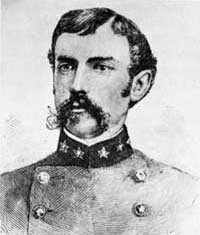|
FORT SUMTER National Monument |
 |
 Col. Alfred Rhett. From Johnson, The Defense of Charleston Harbor. |
 Bvt. Maj. Gen. Quincy A. Gillmore. From Johnson, The Defense of Charleston Harbor. |
The Morris Island
Approach to Fort Sumter
Folly Island and Cole's Island, next south of Morris Island, had been occupied by Northern troops just prior to the naval attack. In June and July, the northern end of Folly Island was fortified. In a remarkable operation, 47 guns and mortars were secretly placed "within speaking distance of the enemy's pickets." Some 11,000 men were concentrated on the island. Brig. Gen. Quincy A. Gillmore, the "breacher" of Fort Pulaski, assumed command on June 12. Rear Adm. John A. Dahlgren superseded Admiral Du Pont on July 6.
During that time the Confederates mounted guns at the southern end of Morris Island and built up the earthworks at its upper end—Battery Gregg at Cummings Point and Battery Wagner some 1,400 yards to the south. The latter work, commanding the island at its narrowest point, was made into a formidable "sand fort" mounting about 15 guns.
Fort Sumter, 1,390 yards distant from Battery Gregg, prepared for siege, too. Brick and stone masonry "counterforts," already built at each extremity of the esplanade as protection for the magazines, were now strengthened, and much of the remaining gorge exterior was sandbagged, or otherwise protected. The casemates on the right flank ("sea front") were filled with sand, and the rooms on the gorge were filled with damp cotton bales laid in sand. The upper-tier magazines were abandoned and filled with sandbags to protect the magazines below. Protective revetments and defensive devices of various sorts were introduced at various points throughout the fort. During this period the garrison was host at frequent intervals to officers on leave, citizens of Charleston, and even many ladies, who came to see the scars of the April battle, to admire the drill, or to observe the preparations. At the end of June 1863, Fort Sumter was garrisoned with 5 companies (perhaps 500 men) of the First South Carolina Artillery, under the command of Col. Alfred Rhett. Its armament, meanwhile, had been reduced to 68 guns and mortars, many of the finest pieces having been removed to strengthen other fortifications about the harbor.
On the morning of July 10, 3,000 Union infantrymen, supported by the artillery on Folly Island and the guns of 4 monitors, descended on the southern end of Morris Island. Brig. Gen. Truman Seymour, a company commander at Fort Sumter 2 years before, commanded the assault. Within 4 hours, three-fourths of Morris Island was in his hands. Hopelessly outgunned and outmanned, the Confederate forces fell back to Battery Wagner. The guns of Fort Sumter helped to cover the retreat.
A "desperate" assault upon Wagner the following morning failed, though the parapet was briefly gained. General Gillmore established counterbatteries and tried again on the 18th. From noon until nightfall that day "without cessation or intermission," Federal guns poured a "storm of shot and shell upon Fort Wagner ... perhaps unequalled in history"; then, some 6,000 troops assaulted—in the van, the 54th Massachusetts, "the first colored regiment of the North to go to war." In a short savage struggle, Seymour's force suffered 1,500 casualties. Though one angle of the fort was gained and held for a time, the attack was repulsed.
Thwarted in his plan to secure easy possession of Morris Island as a base for breaching operations against Fort Sumter, General Gillmore now determined to attempt that fort's reduction from the ground already in his possession. Batteries Wagner and Gregg would be taken by protracted siege operations. At Fort Sumter, removal of guns and ammunition continued apace. Anticipating that Sumter was "liable to be silenced sooner or later," and fearing attack at other points about the harbor, the Confederate authorities husbanded their resources. By mid-August, Fort Sumter's armament was reduced to a safe minimum of 38 guns and 2 mortars.
At distances of 2 to 2-1/2 miles from Fort Sumter—distances extraordinary for such operations—Gillmore set up eight batteries of heavy rifled cannon. In the marsh west of Morris Island, where the mud was "like liquid," his engineers successfully emplaced a "200 pounder" to fire on Charleston; this was to be the notorious "Swamp Angel."

|
|
Last Modified: Mon, Dec 2 2002 10:00:00 am PDT |


